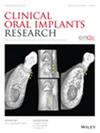种植体周围重建治疗的长期治疗结果:一项随机临床试验的7年生存率和成功。
IF 5.3
1区 医学
Q1 DENTISTRY, ORAL SURGERY & MEDICINE
引用次数: 0
摘要
目的:报告一项随机临床试验的7年结果,评估骨替代物联合浓缩生长因子(CGF)或胶原膜(CM)治疗种植体周围炎的重建手术。材料和方法原始人群包括57例患者,其中至少有一个种植体被诊断为种植体周围炎,表现为两、三或四壁骨内缺陷≥3mm,用异种植骨材料填充,并用CGF或CM覆盖。临床和影像学参数、治疗成功率和疾病复发率在7年的支持性牙周/种植体周围护理随访期间进行评估。研究预后指标/预测因子与治疗成败的关系。结果16例(24颗种植体)(CGF组)和18例(25颗种植体)(CM组)完成了7年的随访。虽然观察到临床和影像学结果的短期改善,但随着时间的推移,发现了复发的趋势。在种植体水平,与CGF组相比,CM组在最深PPD和x线垂直缺损深度方面表现出更有利的结果(p = 0.040和p = 0.043)。7年时,23.1%的CGF和30.8%的CM患者治疗成功,34.6%和30.8%的患者复发(p < 0.05)。基线化脓的存在是治疗失败的唯一显著患者水平预测因子(OR = 15.45;95% ci: 1.42-168.5;p = 0.02)。结论两种方案的临床和影像学结果相当。长期治疗的成功是有限的,失败率随着时间的推移而增加。基线化脓对治疗结果有显著的负面影响。本文章由计算机程序翻译,如有差异,请以英文原文为准。
Long-Term Treatment Outcomes of Peri-Implantitis Reconstructive Therapy: 7-Year Survival and Success of a Randomized Clinical Trial.
OBJECTIVES
To report the 7-year outcomes of a randomized clinical trial evaluating a reconstructive surgical procedure of peri-implantitis with a bone substitute in combination with either concentrated growth factor (CGF) or collagen membrane (CM).
MATERIALS AND METHODS
The original population consisted of 57 patients with at least one implant diagnosed with peri-implantitis exhibiting two-, three-, or four-wall intrabony defects ≥ 3 mm which were filled with a xenogenic bone grafting material and covered with either CGF or CM. Clinical and radiographic parameters, treatment success, and disease recurrence frequencies were evaluated over the 7-year follow-up period of supportive periodontal/peri-implant care. Relationships between prognostic indicators/predictors and treatment success and failure were investigated.
RESULTS
Sixteen patients (24 implants) (CGF group) and 18 (25 implants) (CM group) completed the 7-year follow-up. Although short-term improvements in clinical and radiographic outcomes were observed, a tendency toward relapse was detected through time. At implant level, CM group demonstrated significantly more favorable outcomes for deepest PPD and radiographic vertical defect depth (p = 0.040 and p = 0.043) compared to CGF group. At 7 years, treatment success was achieved in 23.1% of CGF and 30.8% of CM patients, while disease recurrence occurred in 34.6% and 30.8%, respectively (p > 0.05). The presence of baseline suppuration was the only significant patient-level predictor for treatment failure (OR = 15.45; 95% CI: 1.42-168.5; p = 0.02).
CONCLUSION
Both protocols led to comparable clinical and radiographic outcomes. Long-term treatment success was limited, with increasing failure rates over time. Baseline suppuration had a significant negative impact on treatment outcomes.
求助全文
通过发布文献求助,成功后即可免费获取论文全文。
去求助
来源期刊

Clinical Oral Implants Research
医学-工程:生物医学
CiteScore
7.70
自引率
11.60%
发文量
149
审稿时长
3 months
期刊介绍:
Clinical Oral Implants Research conveys scientific progress in the field of implant dentistry and its related areas to clinicians, teachers and researchers concerned with the application of this information for the benefit of patients in need of oral implants. The journal addresses itself to clinicians, general practitioners, periodontists, oral and maxillofacial surgeons and prosthodontists, as well as to teachers, academicians and scholars involved in the education of professionals and in the scientific promotion of the field of implant dentistry.
 求助内容:
求助内容: 应助结果提醒方式:
应助结果提醒方式:


